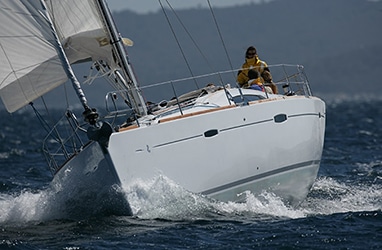
This article is an excerpt from NauticEd’s online FREE Navigation Rules Course, an interactive online sailing course for ALL sailors to learn Navigation Rules and become a safer sailor. Or if you want to learn more, upgrade to the Skipper Course Bundle to become a competent sailor!
You can learn to sail and improve your sailing with NauticEd, the international leader in sailing education.
Action by a Stand-On Vessel Nav Rule
Strangely enough, the written text for the action of a Stand-On vessel is longer than that of a Give-Way vessel.
The Rule
(a) (i) Where one of two vessels is to keep out of the way, the other shall keep her course and speed.
(ii) The latter vessel may however take action to avoid collision by her maneuver alone, as soon as it becomes apparent to her that the vessel required to keep out of the way is not taking appropriate action in compliance with these Rules.
Discussion
Maintaining course and speed is also communicating to the Give-Way vessel and setting a predictable path whereby the Give-Way vessel can take appropriate actions. Predictability is the crux of “Stand-On”. Ever played dance with someone in the grocery store? You’re on a head-on collision in the pastry section, she moves right at the same time you move left. Next thing you know you’re crashing into each other. It’s ok in the grocery store and you might even get a date out of it – on the seas the only date will be one in court.
Note that the rule also says that the Stand-On vessel MAY take action to avoid collision as soon as it becomes apparent that the Give-Way vessel is not taking the appropriate action.
The Rule
(b) When, from any cause, the vessel required to keep her course and speed finds herself so close that collision cannot be avoided by the action of the Give-Way vessel alone, she shall take such action as will best aid to avoid collision.
Discussion
For such a small subsection, this rule is one of the most important rules of all. It says that the Stand-On vessel SHALL take action to avoid collision. It totally takes away your rights in court to argue that you were the Stand-On vessel. If it is deemed that you knew or should have known about the other vessel and did not take action to avoid the collision YOU are the one at fault.
Read this blog article I wrote which shows a major life-threatening situation I was in where I was the Stand-On vessel (I was anchored) yet had the collision occurred, I could have been held responsible.
https://www.nauticed.org/sailing-blog/mayday-mayday-mayday-collision-at-sea/
The Rule
(c) A power-driven vessel which takes action in a crossing situation in accordance with subparagraph (a)(ii) of this Rule to avoid collision with another power-driven vessel shall, if the circumstances of the case admit, not alter course to port for a vessel on her own port side.
Discussion
This means all turns to avoid collision should be immediately away from the vessel. This scenario would occur when a captain thinks he should turn in and just cut in behind the other vessel. According to this rule, he should turn away from the other vessel.
The Rule
(d) This Rule does not relieve the Give-Way vessel of her obligation to keep out of the way.
Discussion
This is also significant. Even if the Stand-On vessel is reacting and making course changes, the Give-Way vessel remains the Give-Way vessel and is responsible for collision avoidance.
Learn Navigation Rules for Free...
A FREE 3-hour course that teaches how to stay safe, avoid collisions and accidents, and learn the “Rules of the Road”. The free Navigation Rules Course is for ALL sailors, whether you’re just learning or need a FREE refresher. Or, consider upgrading to the Skipper Course Bundle to become a fully competent skipper!
